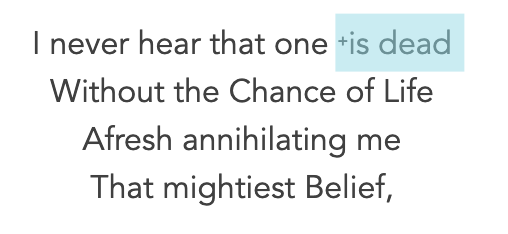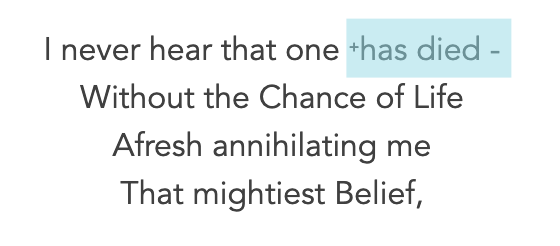About
I had told you I did not print
– from a letter to T. W. Higginson
Emily Dickinson left her life’s work behind in a trunk—mostly unpublished ephemeral manuscript poems that were often “incomplete” with alternate words and phrases in the margins. Her early editors dealt with this ambiguity by making their own decisions to complete the poems before putting them into print, but even the most rigorous print editorial process ignores and obscures the unresolved behavior of the manuscripts.
This project suggests that the real problem is attempting to put Dickinson’s poems into print at all. It argues that the ephemeral poems are intrinsically digital objects—fluid and interactive collections of rhythms and lines, asking to be used and explored. This site allows users to interact with Dickinson’s drafts and experience their publication as an ongoing present moment instead, to “dwell in Possibility” with the poet and create the “fairer house” than print that her poems demand.
…internal difference
Where the meanings are.
– from “There’s a certain Slant of light,”
This project argues that Dickinson’s ephemeral poems should be allowed to wobble on the edge of material indecision between different possible meanings. That readers should be able to encounter the poems in this ambiguity, spinning out the many meanings embedded in the poems’ networks of internal possibility. The site builds on the critical work of Virginia Jackson, who argues in Dickinson’s Misery: a Theory of Lyric Reading that instead of addressing a public audience as a collective by essentially talking aloud to herself, Dickinson’s speaker implicates readers in the material moment of the text’s writing. According to Jackson, every time a Dickinson poem uses the word “I,” the reader is persuaded to be the speaker—to be present at and vital to the moment the poem comes into being.
To use the site
Click the plus signs (+) next to words in the text to create a “new” version of the poem from the alternate words Dickinson left in the margins.
Built and maintained by Kayla Shipp at Emory University.
With thanks to The Emily Dickinson Archive and The Emily Dickinson Museum Archive for making the images in this project freely available.

